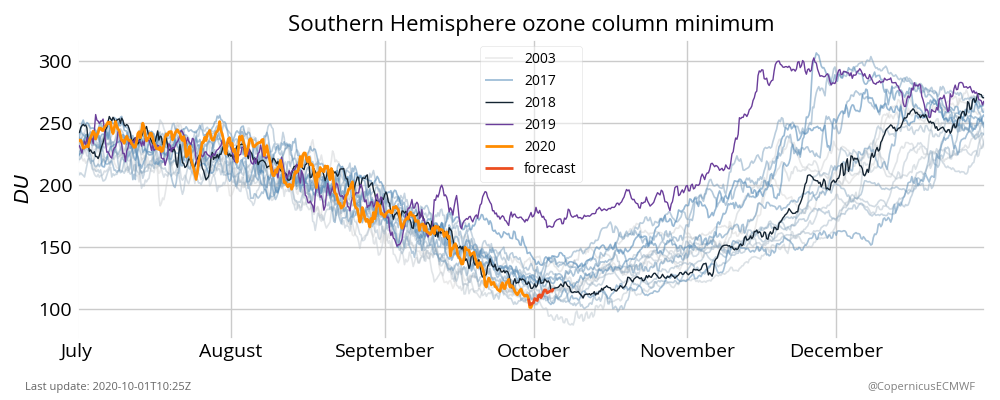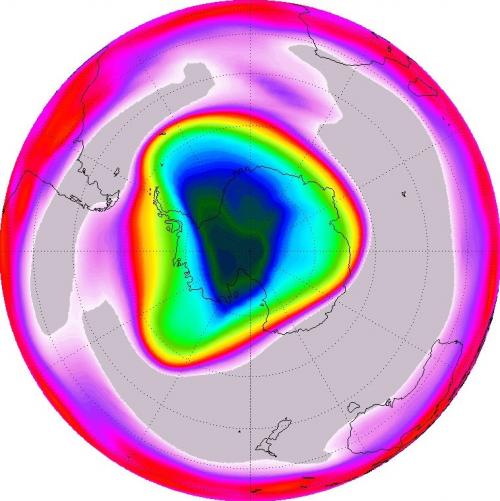The hole in the ozone layer above the Antarctic is very deep this year, due to the exceptionally cold temperatures in the stratosphere. Whereas the ozone hole over Antarctica was the smallest ever measured last year, it could well be one of the largest this year. Whether the ozone hole will actually evolve towards a record, will be confirmed by satellite observations in the coming days and weeks and will depend mainly on the further stability of the stratospheric polar vortex.
The ozone layer protects life on Earth from harmful solar ultraviolet (UV) radiation. In the late 20th century, human emissions of chemical substances called halocarbons adversely affected the amount of ozone molecules in the atmosphere, most notably resulting in the dramatic annual ozone hole over the Antarctic region.
The Montreal Protocol, which came into force in 1987, has curbed the amount of halocarbons in the atmosphere, resulting in the slow recovery of the ozone layer. The Copernicus Atmosphere Monitoring Service (CAMS) is funded by the European Commission to monitor the state of our atmosphere and delivers daily updates about the state of the ozone layer. The Royal Belgian Institute for Space Aeronomy (BIRA-IASB) contributes to CAMS thanks to its expertise in modelling and observations of the ozone layer.
As every year at the beginning of October, the ozone hole is currently reaching its maximum size and depth above the Antarctic. It was very large and deep in 2018, and exceptionally weak last year. CAMS shows that the area covered by the ozone hole this year is as large as in 2018, but the ozone column has not reached such low values since 2003 in early October.


These low ozone values are linked to the meteorological conditions over the Antarctic. Indeed, it is currently exceptionally cold over Antarctica for these days of the year: satellites are measuring the lowest stratospheric temperatures since 2003. A low temperature reflects a stable vortex, which gives rise to more ozone depletion.

The Royal Belgian Institute for Space Aeronomy (BIRA-IASB) contributes to CAMS and runs its own forecasts of the ozone hole. Their model for stratospheric chemistry, the Belgian Assimilation System for Chemical ObsErvations (BASCOE), predicts that the ozone hole this year will approach the previous record of 2006. Satellite observations will confirm whether or not that record will be broken in the coming weeks, depending on the further evolution of the stratospheric polar vortex.
The question now arises: is this exceptionally strong ozone hole related to climate change? Chemistry-climate models show that the Antarctic ozone hole is expected to gradually close, with springtime ozone returning to 1980 values in around 2060. The timing of this recovery does not depend on the increase of Greenhouse Gas concentrations, i.e. it will happen independently of man-made climate change.
Yet this is not the whole story because the exceptional ozone holes reflect extreme meteorological conditions. This is the case both for the exceptionally strong ozone holes encountered this year above the Arctic and the Antarctic and the exceptionally weak ozone hole observed last year above the Antarctic. It is not yet determined if such extreme events could occur more frequently due to climate change.
Contact
- Dr. Simon Chabrillat, research group "Chemical Weather" - Email: simon (dot) chabrillat (at) aeronomie (dot) be
Right: Forecast of the ozone hole for October 2, 2020, from BIRA-IASB's BASCOE model.



